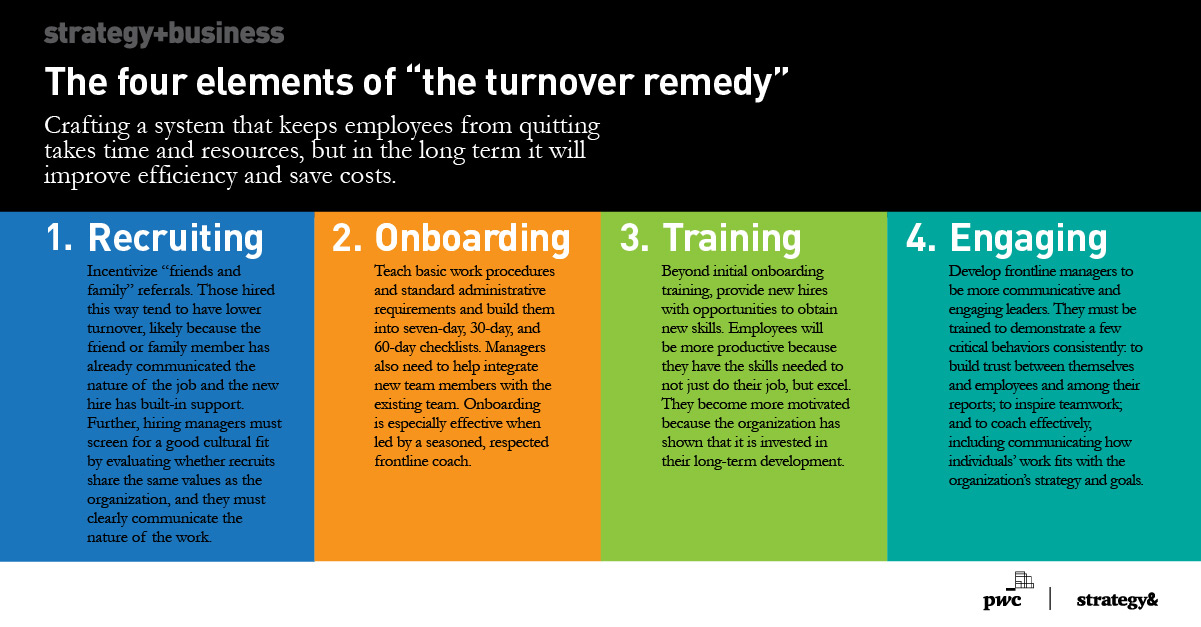The remedy for high turnover
In service industries, where employees frequently quit, upskilling frontline managers and redesigning the hiring and onboarding processes can help ease the pain.
Business leaders know there’s a strong correlation between low employee turnover and high profitability. But executives whose companies are plagued by high turnover either assume nothing can be done or fruitlessly pull on the wrong levers.
This confusion and frustration around finding an efficient and lasting remedy to high turnover stem from two sources: First, executives underestimate the financial and cultural costs of employee turnover. If they had the full picture, there would be no ignoring it. Second, they misunderstand the root causes of turnover, and they are unable to effectively address what they don’t comprehend.
High turnover is commonly attributed to some failure on management’s part. However, an employee’s decision to quit is often influenced by factors outside of a manager’s control, including an undesirable schedule, family illness, or a poor job fit. And some industries — for example, retail, custodial, and food services — simply have perennially high turnover. (There are, however, a few organizations in this realm that break the mold, such as Trader Joe’s and Costco, thanks to the ways in which their employee-focused culture informs their operating models.) To be sure, certain professional positions, such as management consultant, technology user experience designer, and software engineer, are also prone to high turnover because these skills are in great demand. But our focus here is on hourly service industry turnover.
Given the imperative for businesses to manage costs, it’s important to understand what drives employee turnover. We have identified those factors and addressed them with what we call the turnover remedy: four elements that, when combined in a hiring and support infrastructure, will make new hires less likely to quit. Those elements are smarter recruiting, smarter onboarding, continued training, and the deployment of highly skilled frontline managers who are adept at engaging with as many employees as possible.
Digging into the numbers
Leaders can no longer afford to underestimate or ignore the high cost of turnover, which typically equals two to four months of an hourly employee’s pay. In service industries, which are dominated by hourly workers, turnover adds expenses in lost productivity, the need to pay overtime to workers when open positions remain unfilled, and distracted management. We find that in high-turnover service industry businesses, managers spend 10 to 20 percent of their time on recruiting, onboarding, and training new employees, which is on top of the HR team’s efforts. In our experience, leaders simply aren’t aware of how these costs add up.
Further, in service industries, well-trained and experienced employees can be as much as 50 percent more productive than new hires. A new employee spends one to two weeks in training and onboarding during which he or she is unavailable for frontline work. And that new hire often needs four to eight weeks to reach full productivity, during which time that person’s work needs to be supplemented with additional labor or management support.
Finally, as an employee nears quitting, a week or two before the planned departure, that worker often begins to show up late or not at all. Such unreliability leaves gaps in schedules that managers must scramble to fill — either by doing the work themselves and neglecting their own tasks, calling someone else in at the risk of inconveniencing that worker or having to pay overtime, or hiring higher-cost temporary workers; these short-term solutions continue until the position is filled.
Looking at the real turnover drivers
Clearly, turnover costs need to be abated. But few organizations have a grasp of how to remedy high turnover because leaders don’t understand what really drives it.
Few organizations have a grasp of how to remedy high turnover because leaders don’t understand what really drives it.
Drivers of turnover change somewhat over an employee’s tenure. Turnover rates are highest in the first three months. In our experience, that’s because the early months are when the reality of the job and company culture sinks in. Those who find those things to be a poor fit will leave. From months three to 12, turnover declines, and employees who leave do so for multiple reasons, including their relationship with their manager and coworkers. Employees who quit at this phase report frustration at not fully understanding what is expected of them or how to succeed in the eyes of managers, and a lack of camaraderie and support from colleagues. Wages and work schedules are also an issue in this time period. Once an employee completes a full year, turnover declines dramatically; when employees do leave then, it’s most often for personal reasons, including caring for an ailing parent, raising a family, moving, or going to school.
Regardless of tenure, however, it is our experience that the umbrella category of workplace culture is the underlying cause of turnover: a poor employee fit with company values and strategy, unsupportive coworkers, and a manager who lacks skills in communication and people management. Secondary drivers include personal reasons, low wages, and a challenging work schedule.
Employers can’t do much, if anything, about affecting the personal reasons for which employees leave. And they have little room to adjust wages and schedules (see “Ease the burden”). Clearly, focusing on the cultural issues that trigger turnover is an imperative for organizations.
Ease the burden
In the first year on the job, employees often quit for a higher-paying position or because their work schedule becomes difficult to manage. Here are some creative ways to ease those problems and retain more employees.
Problem: An employee is ready to quit to take a significant wage increase at a new employer (say, $2 on a $10/hour wage).
Solution: Although a 20 percent increase is nearly impossible for most companies to match without drastically raising their labor costs, employers can propose other incentives. Consider offering college tuition support and upskilling opportunities on company time as attractive alternatives.
Problem: A full-time employee is finding it difficult to care for her children after school and can’t find a shift that works with her schedule. She thinks she will have to quit and get one or two part-time jobs.
Solution: Companies can make shift work more flexible. Try allowing employees one to two hours off to ferry children to and from school and then have them finish their shift later in the day or start earlier the next day.
Problem: An employee with an ill family member is starting to be called on to care for the family member with little notice. He is having difficulty finding others with whom to swap shifts and thinks quitting is the best answer.
Solution: Apps or other technologies can be used to help hourly employees more easily change schedules. Investment in such tools is a small price to pay both to keep that employee and to reduce absenteeism.
The four elements of the turnover remedy
Companies must invest in formulating a turnover remedy, making quitting less likely. Because a majority of turnover happens in the first three months of an employee’s time with a company, leaders should begin by focusing on ways to reduce the factors causing people to leave at this juncture: misunderstandings about the nature of the job and a poor fit with company culture. This remedy weaves a better understanding of the work and the way things get done within an organization into the three elements that form the first steps of the employee life cycle: recruiting, onboarding, and training. The fourth element focuses on training frontline managers to be more communicative and supportive in order to retain employees after those critical first three months, when unhelpful coworkers and managers become the top reasons for quitting.
Smarter recruiting. Although all organizations generally have recruiting capabilities in place, those actions tend to focus on “what we have always done,” including sourcing candidates from multiple places (corporate website, job search sites, walk-ins, etc.), maintaining perpetually open positions, and continually screening and interviewing candidates. These functions are necessary but do nothing to address the issues that lead to turnover.
To improve sourcing, organizations should incentivize employees to bring in appropriate candidates through “friends and family” referrals. These hires tend to have lower turnover, likely because the friend or family member has already communicated, to some degree, the nature of the job and the new hire has the built-in support of the employee.
Further, during the recruiting stage, hiring managers must screen not just for job skills but for a good cultural fit by evaluating whether potential hires share the same aspirations and values as the organization, whether they are motivated by the same things as top employees, and whether they are likely to enjoy the work environment. The nature of the work must be communicated clearly and frankly so new hires don’t have a rude awakening once work begins. HR must provide details about scheduling, the organization’s culture and strategy, and what a typical workday looks like.
Although it can be tempting to hire “anyone with a pulse,” those who don’t fit in with the culture or who are misinformed about the job will leave as soon as the truth comes to light. Companies must avoid wasting resources on mis-hires or they’ll find themselves back in the same spot, scrambling to fill openings.
Comprehensive onboarding. Once an employee accepts an offer, comprehensive and organized onboarding is critical for creating positive first impressions, goodwill, and a strong foundation of understanding and skills. This process is often short-changed owing to operational and budgetary pressures to push employees through the pipeline quickly. Is it any wonder that exiting employees say part of the reason for quitting is that they don’t understand what is expected of them and how to execute their tasks? Further, they say they don’t feel as if managers and coworkers are invested in getting them up to speed. These issues must be addressed in the onboarding program.
Of course, onboarding is much easier when work processes are simple and enabled by intuitive technology — unfortunately not the case in many companies. But whatever the company, the onboarding process should consist of teaching basic work procedures, standard administrative requirements, and management expectations that are built into seven-day, 30-day, and 60-day checklists, with HR and frontline managers working together to develop them.
Managers also need to help integrate a new hire with the existing team. It’s easy for veterans to ignore recruits, especially when the job has in the past been something of a revolving door. But onboarding is especially effective when led by an “onboarding coach,” a seasoned, respected frontline employee who loves teaching and is genuinely interested in people. Managers must find these people and formally appoint them to onboard new employees. Make the role special by communicating that educating and integrating new hires is important to the organization and that the onboarding coach job is held in high esteem.
Continued training. Beyond the initial training received during onboarding, it’s wise to provide new hires with additional opportunities to obtain new skills. This clearly communicates a culture that invests in its workers and gives them the tools to succeed. Employees will be more productive because they have the know-how to not just do their job, but excel. Employees may even set their sights on staying longer than they had intended as they contemplate advancing within a company whose culture they find supportive.
Job aids such as employee playbooks or laminated process cards, online trainings, and on-the-job trainings are all useful. But many companies are cutting back on time and budget to train employees, under pressure to cut costs. This is shortsighted and will backfire by fueling turnover and perpetuating lower productivity. Just as comprehensive and organized onboarding is necessary to reduce turnover, so is continued upskilling.
Cultivating good managers. Organizations must also focus on cultivating a work culture that reduces turnover as much as possible and keeps employees engaged. To do so, companies need to invest time and resources in training and developing frontline managers to be better leaders. They must engage with their teams and demonstrate a few critical behaviors consistently: build trust, inspire teamwork, and coach effectively.
Managers must build trust among their workers by getting to know their team at a personal level as individuals, by being open and transparent, and by treating staff equitably. They inspire by relating day-to-day work to a higher purpose, promoting collaboration, and celebrating team wins. These good managers coach by delivering candid and constructive feedback, discussing career goals, and connecting people to opportunities.
It may sound like a lot of added work for frontline managers. But if they spend their time on improving the business performance through current employees, they will spend less time recruiting new ones and filling holes in the schedule.
Planning for the long term
Understanding how costly turnover is and what actually drives it, then addressing those specific issues with the turnover remedy, will go a long way toward combating a problem that has dogged the service industry for years.
Creating and deploying the remedy demands a rethinking of the early stages of a worker’s tenure and the role HR and frontline managers must play. It also requires an investment of time and resources into redesigning the recruiting, onboarding, and training processes and developing frontline managers to be better leaders. With patience and persistence, companies can lessen the costly problem.
Any organization seeking to reduce high employee turnover must think long-term and begin to put these plans into action now, knowing they will yield huge cost savings and increased productivity down the road. Otherwise, companies will continue to waste precious resources on high turnover.
Author profiles:
- Augusto Giacoman advises companies on people and organizational issues for Strategy&, PwC’s strategy consulting business. He is a principal with PwC US, based in New York.
- Deniz Caglar is an advisor to executives on strategic cost and organizational transformation for Strategy&. Based in Chicago, he is a principal with PwC US. He is a leader in the PwC US organization strategy practice and a coauthor, with Vinay Couto and John Plansky, of Fit for Growth: Strategic Cost Cutting, Restructuring, and Renewal.




